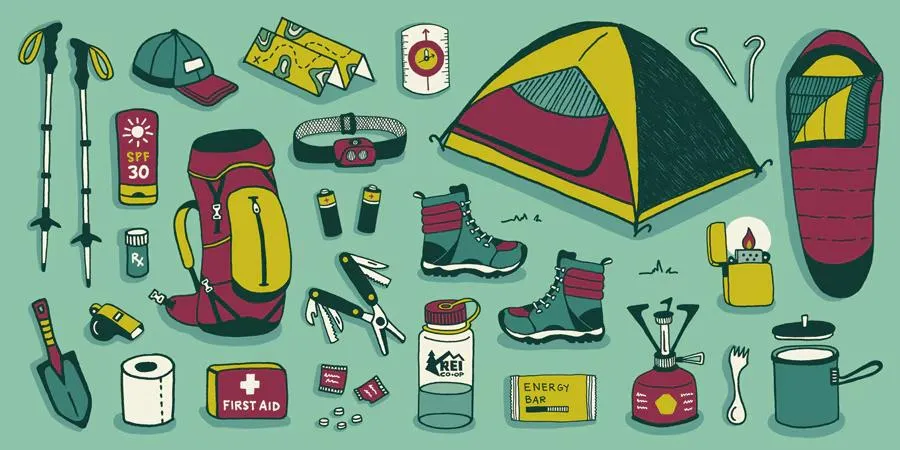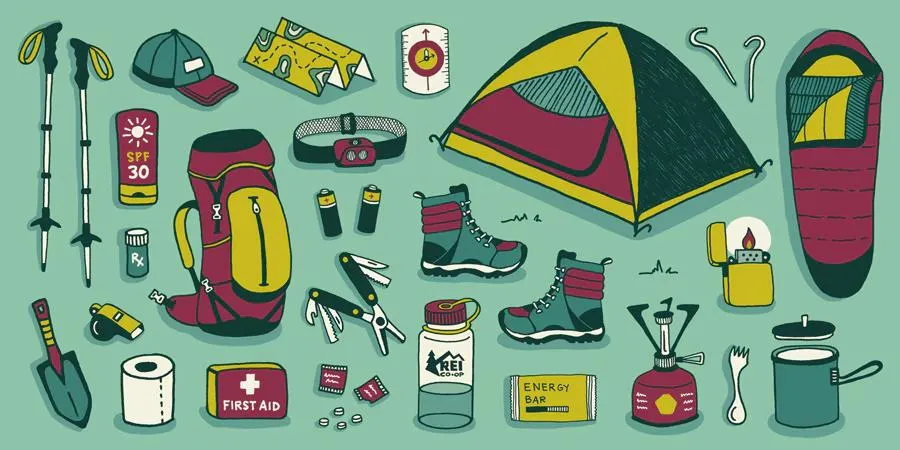
The Complete Hiking Gear Checklist: Essential Equipment for Every Adventure
The Complete Hiking Gear Checklist: Essential Equipment for Every Adventure
Planning your next hiking adventure requires careful preparation, and having the right hiking gear checklist can make the difference between a memorable experience and a dangerous situation. As someone who has explored trails across the country for over a decade, I've learned that proper gear selection is crucial for safety, comfort, and enjoyment on the trail. Whether you're planning a short day hike or a multi-day backpacking expedition, this comprehensive guide will help you prepare for any outdoor adventure. For more outdoor inspiration and expert tips, visit NatureGuests.com - your ultimate resource for outdoor adventures.
Essential Hiking Gear for Every Adventure
.webp)
Creating a comprehensive hiking gear checklist starts with understanding the fundamental items every hiker needs, regardless of trail difficulty or duration. During my years of guiding hiking groups through various terrains, I've witnessed how proper gear selection can transform a challenging hike into an enjoyable experience.
The foundation of any good hiking gear checklist begins with the "Ten Essentials" - a time-tested system developed by mountaineering organizations. These essential categories include navigation tools, sun protection, insulation, illumination, first-aid supplies, fire-starting materials, repair kit, nutrition, hydration, and emergency shelter. Each category serves a specific purpose in keeping you safe and comfortable on the trail.
The Core Components
Every effective hiking gear checklist should include these fundamental categories: footwear, backpack, navigation tools, water and hydration systems, food and nutrition, clothing layers, safety equipment, and tools. The specific items within each category will vary based on your hiking objectives, but these categories remain constant.
Your backpack serves as the foundation for carrying all essential gear. I recommend investing in a quality daypack for shorter hikes or a larger backpacking pack for multi-day adventures. The OutdoorMaster 50L Hiking Backpack offers excellent value with its lightweight design and waterproof construction, making it perfect for both day hikes and overnight trips.
Navigation tools remain critical components of any hiking gear checklist. While smartphone apps provide convenient navigation, I always carry a physical map and compass as backup. Weather conditions, battery life, and signal coverage can all impact digital navigation, making traditional tools essential for safety. For detailed guidance on building your gear collection, check out our comprehensive guide on essential hiking gear.
Day Hiking Essentials
Day hiking requires a streamlined approach to gear selection, focusing on essentials while maintaining comfort and safety. My hiking gear checklist for day hikes has evolved through countless trail experiences, from sunrise summit attempts to afternoon nature walks with family.
Clothing and Footwear
Proper clothing forms the foundation of comfort during day hikes. I recommend moisture-wicking base layers, breathable hiking pants or shorts, and a lightweight jacket for changing weather conditions. Your clothing should adapt to temperature fluctuations throughout the day, which is why layering remains essential in any hiking gear checklist.
Footwear selection depends on terrain and personal preference. For rocky or uneven trails, I prefer sturdy hiking boots like the Merrell Moab 3 Waterproof Hiking Boots, which provide excellent ankle support and traction. For easier trails, lightweight hiking shoes or trail runners offer comfort and flexibility.
Hydration and Nutrition
Water requirements vary based on activity level, weather conditions, and individual needs. I typically carry 2-3 liters for full-day hikes, using a combination of water bottles and hydration bladders. The Hydro Flask 32 oz Wide Mouth Bottle keeps water cold throughout the day and fits easily in most backpack side pockets.
Nutrition planning involves balancing energy needs with pack weight. I pack easily digestible snacks like trail mix, energy bars, and dried fruit for sustained energy throughout the hike. For longer day hikes, I include a substantial lunch with protein and complex carbohydrates. Our detailed day hike packing list provides comprehensive food planning strategies.
Pro Tip: Weather Preparation
Weather conditions can change rapidly in mountain environments. I always check forecasts before departure and pack extra layers even on sunny days. This preparation has saved me from uncomfortable situations during unexpected weather changes.
Multi-Day Backpacking Gear

Multi-day backpacking requires a comprehensive hiking gear checklist that extends beyond day hiking essentials. During my solo backpacking trips across national parks, I've refined my gear selection to balance functionality with weight efficiency. Every item must serve multiple purposes or provide essential safety and comfort benefits.
Shelter and Sleep Systems
Your shelter system forms the foundation of overnight comfort and safety. I recommend lightweight, three-season tents for most backpacking scenarios, with four-season options for winter conditions. The tent should provide adequate weather protection while minimizing pack weight and setup complexity.
Sleep systems include your sleeping bag, pad, and pillow. Temperature ratings should match expected nighttime lows with additional margin for safety. I prefer down-filled sleeping bags for their warmth-to-weight ratio, paired with closed-cell foam or inflatable sleeping pads for insulation and comfort. The Klymit Static V2 Sleeping Pad offers excellent comfort and packs incredibly small.
Cooking and Food Storage
Cooking systems for backpacking must balance functionality with weight constraints. Lightweight canister stoves provide reliable performance and easy operation, while liquid fuel stoves offer better cold-weather performance. I typically carry a compact canister stove with titanium cookware for most trips.
Food storage involves both preservation and wildlife protection. Bear canisters or rope hanging systems keep food secure from animals while maintaining freshness. I plan meals around dehydrated options, supplemented with fresh foods for shorter trips. For comprehensive meal planning strategies, explore our guide to multi-day hike packing lists.
Water treatment becomes critical during multi-day trips. I carry both filtration and purification options, typically using a lightweight pump filter combined with purification tablets for backup. This redundancy ensures safe drinking water throughout the expedition, which is essential for any extended hiking gear checklist.
Seasonal Gear Considerations
Seasonal variations significantly impact your hiking gear checklist requirements. Through hiking experiences across different seasons and elevations, I've learned that adaptability and preparation are key to enjoying outdoor adventures year-round. Each season presents unique challenges and opportunities for exploration.
Spring and Summer Hiking
Spring hiking requires versatility in your hiking gear checklist due to unpredictable weather patterns and varying trail conditions. I carry microspikes for icy morning conditions, waterproof layers for afternoon thunderstorms, and insect protection for emerging bug populations. Layering becomes crucial as temperatures fluctuate throughout the day.
Summer hiking emphasizes sun protection and heat management. I prioritize lightweight, breathable clothing with UPF ratings, wide-brimmed hats, and quality sunglasses. Increased water requirements and electrolyte replacement become essential during hot weather hiking. Early morning starts help avoid peak heat while providing better wildlife viewing opportunities.
Summer Safety Reminder
Heat-related illnesses can develop quickly during summer hiking. I always carry extra water, electrolyte supplements, and plan routes with shade options. Recognizing early signs of heat exhaustion has prevented serious situations during high-temperature hikes.
Fall and Winter Preparations
Fall hiking presents some of the most rewarding outdoor experiences, but your hiking gear checklist must account for rapidly changing conditions. I pack additional insulation layers, waterproof protection, and emergency shelter options. Daylight hours decrease significantly, making headlamps and extra batteries essential equipment.
Winter hiking requires specialized gear and experience. Four-season tents, winter-rated sleeping bags, and mountaineering equipment become necessary for safe winter camping. I recommend gaining experience with experienced winter hikers before attempting solo winter expeditions. Proper training and gear selection are crucial for winter safety.
Safety and Emergency Equipment
Safety equipment represents the most critical components of any hiking gear checklist. During my years of hiking, I've encountered various emergency situations where proper preparation made the difference between minor inconvenience and serious danger. Every hiker should prioritize safety gear regardless of experience level or trail difficulty.
First aid supplies form the foundation of hiking safety. I carry a comprehensive first aid kit containing bandages, antiseptic wipes, pain relievers, blister treatment, and emergency medications. The Adventure Medical Kits Sportsman 300 provides excellent coverage for groups and extended trips.
Communication devices provide essential safety backup in remote areas. I carry a satellite communicator for emergency situations and regular check-ins with family. These devices can summon rescue services when cellular coverage is unavailable, providing peace of mind during solo adventures.
Emergency shelter options should be included in every hiking gear checklist, even for day hikes. Lightweight emergency bivouacs, space blankets, or ultralight tarps can provide life-saving protection during unexpected weather or injury situations. These items occupy minimal pack space while offering significant safety benefits.
Fire-starting materials serve multiple emergency functions beyond cooking. I carry waterproof matches, lighters, and fire starters for emergency warmth, signaling, and morale. Practicing fire-starting skills in various conditions ensures competency when emergency situations arise. For comprehensive safety planning, review our detailed backpacking gear list.
Expert Packing Tips
Efficient packing transforms your hiking gear checklist from a burden into a well-organized system. Through years of refining my packing techniques, I've developed strategies that maximize space utilization while maintaining easy access to essential items. Proper organization can significantly impact your hiking experience.
Weight distribution affects hiking comfort and safety. I place heavy items close to my back and centered in the pack, with lighter items at the top and bottom. This configuration maintains balance and reduces strain during long hiking days. Frequently needed items like snacks, water, and rain gear should remain easily accessible.
Packing Efficiency Strategies
- Use compression sacks for sleeping bags and clothing
- Stuff socks and underwear inside cook pots to save space
- Attach frequently used items to pack exterior with carabiners
- Pack emergency items in waterproof containers
- Create a gear checklist specific to your typical hiking destinations
Gear selection should prioritize multi-functional items that serve multiple purposes. I choose gear that combines functions whenever possible, such as trekking poles that convert to tent poles, or smartphones that serve as cameras, GPS devices, and emergency communication. This approach reduces pack weight while maintaining functionality.
Pre-trip testing ensures all gear functions properly before departure. I test equipment at home, checking battery levels, fuel supplies, and gear functionality. This preparation prevents equipment failures during critical moments and builds confidence in your gear selection. Regular maintenance extends equipment life and reliability.
Customizing your hiking gear checklist based on personal experience and specific destinations improves efficiency over time. I maintain different checklists for various trip types, seasonal conditions, and group compositions. This specialization reduces packing time and ensures appropriate gear selection for each adventure. For more detailed packing strategies, check out our complete guide to hiking gear checklists.
Conclusion
Developing a comprehensive hiking gear checklist represents one of the most important skills for safe and enjoyable outdoor adventures. Through careful planning, proper gear selection, and regular practice, you can confidently tackle any hiking challenge while maintaining safety and comfort throughout your journey.
Remember that your hiking gear checklist should evolve with your experience and changing needs. What works for one hiker might not suit another, and what's appropriate for one season may be inadequate for another. Start with the basics, gain experience, and gradually refine your gear selection based on actual trail conditions and personal preferences.
The investment in quality gear pays dividends through years of reliable performance and enhanced outdoor experiences. Focus on building your kit gradually, prioritizing safety equipment first, then comfort and convenience items. Regular maintenance and proper storage ensure your gear remains ready for any adventure that calls to you.
Ready to Start Your Next Adventure?
Use this comprehensive hiking gear checklist to prepare for your next outdoor adventure. Remember, the best gear is the gear you know how to use properly. Practice with your equipment, stay informed about trail conditions, and never stop learning from fellow hikers and outdoor enthusiasts.
Happy trails, and may your adventures be filled with stunning views, memorable experiences, and safe returns home!

